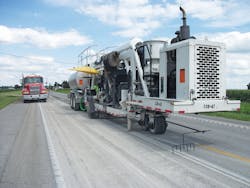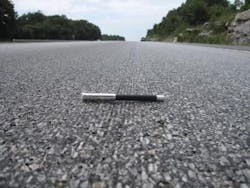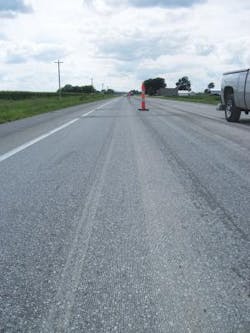By: Tina Grady Barbaccia
When the asphalt surface of U.S. 412 in southern Missouri required pavement preservation to repair cracking and increasing roughness, the project was scoped using diamond grinding as the primary preservation treatment.
Diamond grinding is a pavement preservation technique that improves pavement friction characteristics while providing a smoother ride.
Prior to commencing the diamond-grinding operation, potholes were patched and repaired, said Shane Durnil, former project manager for Chester Bross Construction, based in Hannibal, Mo. Wheel paths were rutted, so the middle hump (.5 to .75 in.) was removed using diamond grinding to improve the ride and drainage characteristics. “From the onset, an overlay was not considered,” Durnil said.
“In other situations, diamond grinding has been used on new asphalt, particularly interstate pavement, to mitigate flushing and possible loss of texture for skid resistance,” explained John Donahue, P.E., construction and materials liaison engineer for the Missouri Department of Transportation (MoDOT).
Flushing, also known as “bleeding,” is asphalt that migrates to the pavement surface and appears as a shiny black film. It is caused by a combination of excessive effective asphalt content, hot weather, low air voids and low asphalt viscosity. Diamond grinding eradicates the asphalt film and exposes the durable aggregate for improved texture.
A close-up of finished diamond-ground surface.
Better texture = better safety
Stone-mastic asphalt (SMA), also known as stone-matrix asphalt, is a gap-graded mix requiring a higher asphalt cement content than conventional hot-mix asphalt. Fibers are often incorporated in the SMA mix design to bind or stiffen the asphalt cement and help eliminate “drain-down.”
“However, even with fibers,” Donahue said, “there is a possibility that after placement, traffic driving over the SMA will force some of the asphalt to the surface.”
Typically, natural removal of the excess asphalt from travel wear takes up to several weeks, depending on environmental and traffic conditions. But cold weather can harden the excess asphalt and prolong it from wearing off. When SMA mix is placed shortly before the onset of cold weather, MoDOT has made the decision in the past to diamond-grind the surface.
Besides exposing larger aggregate for improved macrotexture, grinding also produces a corrugated surface with channels for water to disperse beneath vehicle tires creating a safer driving surface. Donahue said that in MoDOT’s experience, the ground texture holds up very well under high traffic and has a pleasing appearance.
Donahue points out the misconception that diamond grinding can open up voids in asphalt and allow water to infiltrate or destabilize the roadway’s structure. If a mix is properly compacted at the correct density and additives have been used to prevent stripping, water should not create any problems in the voids.
U.S. 412 is Missouri’s marquee project for rehabilitating existing asphalt pavement with diamond grinding. MoDOT now considers diamond grinding a cost-saving alternative to overlays for other projects. It can level moderate to slight rutting, eliminate top-down cracking up to .25 in. deep and rejuvenate oxidized surfaces.
The length of time the texture lasts after grinding depends, according to Donahue, on the traffic level. “The conservative side is a few years,” he said. “But based on what I have seen so far, you can get up to five to seven years. At that point, you are close to the lifespan of a thin [overlay] treatment, so grinding asphalt can give you a comparable performance life to some thin asphalt treatments for less money.”
In addition to diamond grinding, grooving—cutting narrow, discrete grooves into the pavement surface—also is a pavement-preservation method used throughout the state. Grooving is performed in areas where the texture on an aging asphalt pavement has become worn and polished, and there is concern that water on the roadway cannot be evacuated quickly enough.
U.S. 412 with finished diamond-ground surface.
Incentivized grinding
Although grinding and grooving are not the solutions for every distress, diamond grinding will continue to be specified by MoDOT, Donahue said. “There are a multitude of situations where it works well,” he said. This is notable because there is a cost savings per lane mile, and cash-strapped DOTs are looking to save money wherever possible.
It also is becoming a regularly utilized strategy, not just when a specific problem needs to be addressed or as an alternative strategy. Missouri started using this repair technique in the mid-1990s, but it began to gain more traction in the early 2000s. Now, smoothness specification incentives are enticing contractors to grind at the time of construction.
The International Roughness Index (IRI), the road roughness index most commonly used worldwide for evaluating and managing road systems, is used as the smoothness index for Missouri’s pavements. IRI is used to evaluate new pavement construction, which also helps determine penalties or bonus payments to contractors based on the smoothness achieved.
Missouri specifies a maximum average IRI of 80 in. per 1⁄10-mile segment at the time of construction. When contractors lower the IRIs to certain levels, they can get a bonus.
“Contractors can earn 3% or 5% on top of the sq-yd price,” Donahue said. “It’s at a level where for most projects, contractors elect to grind pavement knowing they can achieve a bonus. By making that incentive worthwhile enough for contractors, we have quite a few pavements diamond-ground at the time of construction.”
The future of diamond grinding
Donahue said diamond grinding won’t completely replace thin overlays because the condition of some pavements is too poor for diamond grinding to be effective.
“There are some pavements that won’t be receptive to grinding, such as ones that show signs of stripping or raveling,” he said. “You’re looking for pavement that is in structurally sound condition, but needs rejuvenation and primarily has surface defects, i.e., slight to moderate rutting, shallow top-down cracking, or oxidation where it starts looking whitish and brittle.”
According to Donahue, diamond grinding’s success is evident. “I haven’t done any detailed analysis since 2005-2006 when [MoDOT] let a lot of projects with thin overlays and diamond grinding on high-volume principal arterials to raise the statewide smoothness level,” he said. “We analyzed the results of the diamond-grinding projects.”
Focusing on interstate projects, Donahue tabulated the before and after IRI numbers collected with the MoDOT Automated Road Analyzer (ARAN) to compute the percentage of improvement. Roughness decreased an average of 40 in. per mile, thus justifying the money spent for grinding. In the end, the taxpayers benefit from a smoother, safer and less expensive driving experience. R&B
About The Author: Barbaccia is with Constructive Communication.





